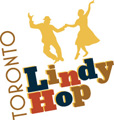This Past April, the Toronto Star did an article on Swing Dancing here in Toronto. Check it out!
By: Dylan C. Robertson News reporter, Published on Tue Apr 15 2014
Six strangers form a circle in a dance studio above a Yonge-Bloor shoe shop. They exchange some nervous laughs.
“Before we start, what image that comes to mind when you think of swing dancing?” asks Mandi Gould, founder of Bees’ Knees Dance.
Responses vary. A middle-aged man in a suit mentions energy, while a teenager in a T-shirt is excited by jumps and swings.
“You do see some crazy moves with advanced dancers at competitions,” Gould tells the group. “But you’ll see that anyone can do Lindy Hop,” the original form of swing dance.
Gould turns on a Louis Armstrong classic and leads the group through some simple movements. Within minutes, the suited man sways his hips, and a timid woman starts snapping her hands.
The six congregated here are among hundreds of Torontonians who try swing dancing each year. Studios and dance groups have noticed a recent uptick in those who catch the jitterbug.
“I do think it’s become more popular recently,” says Gould. She expanded Bees’ Knees Dance into a permanent, full-time studio in 2012, after sharing a space for three years and renting rooms for 10 years. “More people are entering the scene.”
Cultural historians believe swing dancing originated in the 1910s across African-American communities. A partnered dance in Harlem called Lindy Hop gained mass media attention in 1927. The fast-paced jazz dance quickly spread across North America, sparking variations like the Charleston and the jitterbug.
Swing dancing gets its name from the variations or “swings” thrown into the rhythms of performed jazz music. Rock and roll took over dance clubs after Second World War. But swing saw a revival in the late ’90s, when movies like Swingers or the Gap’s “khaki swing” commercial brought the style to a mass audience.
“Groups and events have built up a Toronto community since the ’90s,” says Brian Gottheil, who co-founded UT-swing, a University of Toronto club, in 2007. “I think you now see the results of that, together with swing in the media.”
Swing dancing is featured prominently in the recent Great Gatsby remake, and appears in shows like Boardwalk Empire and Dancing with the Stars. Meanwhile, the recent electro-swing genre has DJs combining old recordings with new sounds.
“You do see swing dancing around more in the last few years, but I think it’s really this welcoming community that brings people in,” says UT-swing vice-president Hannah Bild-Enkin. “You get active, you meet people and you can be a total geek about it.”
UTswing has around 60 registered members, and 30 people usually show up for weekly drop-ins — half of whom are students. But the city’s biggest weekly event happens at the Dovercourt House, where Swing Toronto holds a dance every Saturday night.
Shirqille Williams has come with two other U of T students to practice some basic steps. It was the Gatsby movie that originally led her to UT-swing, and now the Dovercourt House.
“I really like the dance; it’s a lot of fun and you feel like you’re going back to the 1920s, which is really glamorous,” she says.
For an hour, 50 strangers are paired together to learn or practice a sequence of standard moves. When dancing, these moves can be repeated and mixed.
By 10 p.m., training’s over and the regulars arrive, some wearing top hats, suspenders or ball gowns. A live band serenades the crowd with trumpets and a bass violin.
“We’ve seen more people coming out on Saturdays over the past five years,” says Simon Threlkeld, who leads Swing Toronto. He estimates a hundred people attend each Saturday’s dance, with about 50 more for occasional competitions.
Scattered across the thumping floor, a handful of people wear red T-shirts marked “dance ambassador.” The non-profit group Toronto Lindy Hop sends volunteers to the city’s events to help beginners perfect their technique.
“Swing dance is collaborative,” says Threlkeld, peering across the dancefloor. Experienced couples chop their feet, while giggling beginners twirl back and forth.
“It makes it a lot of fun.”



